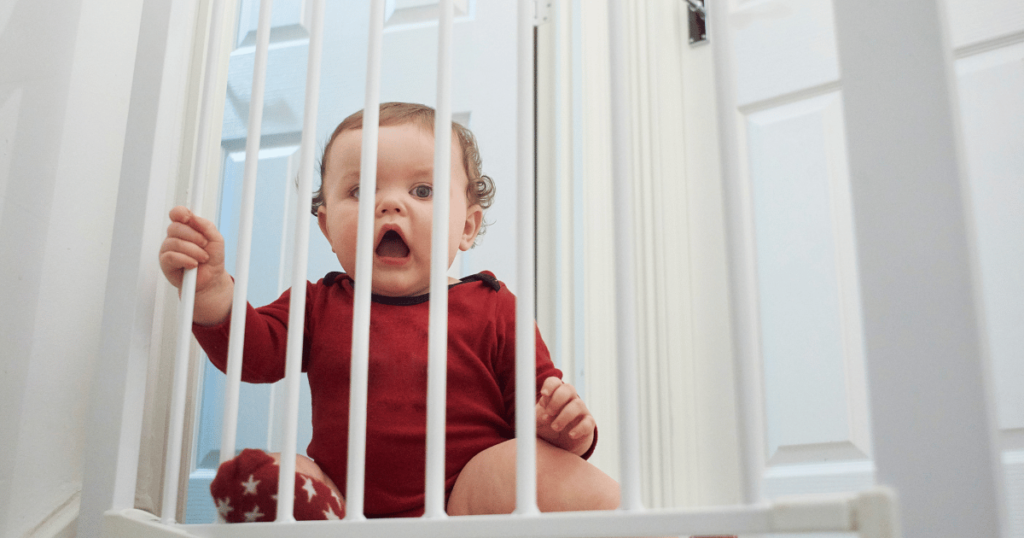Baby-proofing stairs is crucial as your little one begins to explore. Falls on stairs pose serious risks, making safety measures a priority. Timing is critical; baby-proof when your baby starts walking, typically between 9 and 12 months. Stair gates, corner guards, and safety netting are essential tools. Explore gate options like pressure-mounted, hardware-mounted, and retractable gates. Proper installation is vital.
Choose corner guards wisely; opt for soft or complex, depending on needs. Safety netting provides an extra layer of protection. DIY ideas offer cost-effective solutions. Balancing safety with adult accessibility ensures a functional living space. Incorporate educational toys, monitor your baby, and transition safety measures as they grow. Parental tips provide practical insights for new parents. Baby-proofing stairs ensure a secure and nurturing environment for your baby’s exploration.
Importance of Baby-Proofing

Baby-proofing is paramount for safeguarding your little ones as they embark on the journey of walking. As babies become mobile, staircases and household hazards pose potential dangers. The importance of baby-proofing lies in mitigating the risk of falls and accidents and ensuring a secure environment. Proactive measures such as installing stair gates, corner guards, and safety netting create a protective barrier.
Addressing these hazards early, typically when babies start walking around 9 to 12 months, fosters a safe space for exploration. By prioritizing baby-proofing, parents provide a foundation for their child’s independence while minimizing the likelihood of injuries.
When to Start Baby-Proofing
Baby-proofing is a crucial step in ensuring the safety of your little one as they reach the milestone of walking. Understanding when to start baby-proofing involves considering the typical age when babies begin to explore their newfound mobility, usually between 9 and 12 months.

As your baby becomes more curious and starts to pull themselves up, cruise along furniture, and eventually take those first wobbly steps, the risks associated with household hazards, especially stairs, increase significantly.
Around 9-12 Months:
This is the general timeframe when most babies start walking. However, it’s essential to observe your child’s individual development. Some may start earlier, while others might take a bit longer.
Signs of Readiness:
Look for signs of readiness, such as increased curiosity, attempts to stand and walk with support, or pulling up on furniture. These are indicators that your baby is gearing up for more independent movement.
Prevention is Key:
Baby-proofing is a preventive measure. By the time your baby is showing signs of mobility, having safety measures in place is vital to avoid accidents and injuries.
Proactive Approach:
Taking a proactive approach to baby-proofing ensures that your home is a safe environment by the time your little one starts exploring. Start preparing the living spaces, especially areas like stairs, a bit in advance.
Gradual Implementation:
Begin with essential baby-proofing items such as installing stair gates, securing furniture, and covering sharp corners. As your baby’s mobility increases, you can adapt and add more safety measures.
Continuous Assessment:
Baby-proofing is an ongoing process. Regularly assess your home for potential hazards and make adjustments as your baby grows and explores different areas.
Common Baby-Proofing Items
Stair Gates
Stair gates are a fundamental baby-proofing tool, providing a barrier that prevents access to stairs. There are various types, including pressure-mounted gates, hardware-mounted gates, and retractable gates, each catering to different needs and preferences.
Choosing Corner Guards
Corner guards are essential to cushion sharp edges, minimizing the impact of accidental collisions. Parents can opt for soft or hard corner guards, depending on the furniture and their baby’s activity level. Proper installation ensures maximum effectiveness.
Safety Netting for Stairs
Safety netting acts as a protective barrier, preventing babies from squeezing through railings. Understanding the options available and following the correct installation procedures are vital for optimal safety.
Stair Gate Options
Pressure-Mounted Gates
Pressure-mounted gates are convenient and easy to install, making them suitable for various spaces. However, they may only be ideal for some staircases, and proper installation is crucial to prevent accidents.
Hardware-Mounted Gates
Hardware-mounted gates provide a more secure barrier, making them suitable for staircases. Understanding the specific requirements for installation ensures a stable and reliable safety measure.
Retractable Gates
Retractable gates offer flexibility and convenience. They are beneficial in spaces where a permanent gate may be impractical. However, proper installation and maintenance are essential for optimal safety.
How to Installing Stair Gates
Installing stair gates is a crucial step in baby-proofing to create a secure environment for your little one. Follow these critical points for a successful installation:
Measure Correctly: Measure the width of your staircase accurately to choose a gate that fits securely.
Choose the Right Gate Type: Select a gate suitable for your staircase, considering options like pressure-mounted, hardware-mounted, or retractable gates.
Positioning Matters: Install gates at both the top and bottom of stairs to prevent access. Also, consider blocking off other potentially hazardous areas.
Secure Mounting: For hardware-mounted gates, ensure a safe and stable mounting to withstand any attempts by your baby to dislodge it.
Follow Manufacturer’s Instructions: Adhere to the manufacturer’s guidelines for installation to guarantee optimal safety.
Regular Checks: Periodically check and tighten any screws or attachments to maintain the gate’s effectiveness.
How to Choosing Corner Guards in baby-proofing

In the process of baby-proofing, choosing the proper corner guards is crucial to ensure your baby’s safety. Here’s a step-by-step guide on how to select and install corner guards effectively:
- Identify Potential Hazards: Survey your home for sharp edges and corners, especially at the baby’s eye level.
- Select Soft or Hard Guards: Decide between soft guards, usually made of foam or rubber, and rigid guards, made of plastic or metal, based on the furniture and potential impact.
- Consider Aesthetics: Choose corner guards that blend with your furniture or surroundings to maintain the visual appeal of your home.
- Measure and Cut: Measure the dimensions of the corners and cut the guards accordingly for a snug fit.
- Adhesive or Mounting: Determine whether you prefer adhesive guards for easy installation or mounting guards for a more secure attachment.
- Follow Installation Instructions: Adhere to the manufacturer’s instructions for proper installation, ensuring the guards stay in place.
- Regular Checks: Periodically check the condition of corner guards and replace or reattach them if they become loose.
- Cover All Sharp Edges: Extend baby-proofing to all potentially hazardous corners, including furniture, countertops, and fireplace hearths.
Safety Netting for Stairs
Safety netting comes in various designs and materials. Ensuring proper installation, with the netting securely attached to prevent gaps, is essential. Regular checks and maintenance contribute to a consistently safe environment.
DIY Baby-Proofing Ideas
For parents looking for cost-effective solutions, there are several do-it-yourself baby-proofing ideas. From repurposing household items to creative solutions, these ideas cater to various preferences while ensuring a safe space for your baby.
Ensuring Accessibility for Adults
Balancing safety measures with adult accessibility is crucial for maintaining a functional living space. Choosing baby-proofing items that are easy for adults to use while providing adequate protection is an essential consideration.
Educational Toys for Stairs
Incorporating educational toys into your stair environment not only adds fun for your baby but also promotes developmental skills. Choose toys that engage your baby’s senses and encourage cognitive growth.
Monitoring Your Baby
While baby-proofing is essential, constant supervision remains a vital aspect of keeping your baby safe. Utilizing technology-assisted monitoring options, such as baby monitors and smart home devices, enhances parental awareness.
Transitioning as Your Baby Grows
As your baby grows and becomes more independent, it’s essential to adapt baby-proofing measures accordingly. Gradual removal of safety items allows your child to explore their surroundings safely, fostering a sense of autonomy.
Parental Tips and Tricks
Parental tips and tricks can be invaluable for navigating the journey of baby-proofing and parenting. Here’s a compilation of practical advice from experienced parents:

Share Experiences: Connect with other parents to exchange insights on effective baby-proofing strategies.
Trial and Error: Be open to trying different baby-proofing methods until you find what works best for your child and home.
Secure Heavy Furniture: Anchor heavy furniture to the wall to prevent tipping, ensuring an extra layer of safety.
Invest in Quality Products: Choose durable and reliable baby-proofing products, even if they come at a slightly higher cost.
Supervision is Key: No amount of baby-proofing replaces the need for constant supervision. Keep a watchful eye on your little one.
Adapt as Your Baby Grows: Adjust baby-proofing measures as your baby develops new skills and becomes more mobile.
Educational Play: Integrate educational toys into baby-proofed spaces to stimulate your child’s development during play.
Communication with Caregivers: Ensure that caregivers and family members are aware of baby-proofing measures and safety protocols.
Stay Informed: Keep up-to-date with the latest safety recommendations and advancements in baby-proofing technology.
Regular Safety Audits: Conduct periodic safety audits of your home to identify and address any potential hazards.
Maintain a Balance: Find the right balance between safety and creating an environment that allows your child to explore and learn.
Prepare for Transitions: Anticipate and plan for transitions in baby-proofing as your child grows, gradually introducing more independence.
Emergency Preparedness: Have emergency numbers and a well-stocked first aid kit readily available in case of any accidents.
Teach Safe Behavior: Begin teaching safe behaviour to your child early, emphasizing the importance of caution around stairs and potential hazards.
Trust Your Instincts: Ultimately, trust your instincts as a parent. If something doesn’t feel safe, address it promptly.
.
Conclusion
Baby-proofing your stairs is a proactive and essential step in creating a safe home environment for your little one. By understanding the importance of early measures, choosing the right baby-proofing items, and adapting as your baby grows, you can ensure a secure and nurturing space for your baby’s exploration.
FAQ
At what age do babies typically start walking?
Babies usually start walking between 9 and 12 months.
Do I need to baby-proof my stairs if I live in a single-story home?
While the risk may be lower, it’s still advisable to baby-proof stairs as a precaution.
Are pressure-mounted gates safe for the top of stairs?
Pressure-mounted gates may not be as secure as hardware-mounted gates for the top of stairs.
When should I transition from baby-proofing to childproofing?
Transition gradually as your child demonstrates increased understanding and responsibility, usually around 2 to 3 years.
Can I use double-sided tape for corner guards?
Double-sided tape may be suitable for some corner guards, but follow the manufacturer’s recommendations for proper adhesion.
















